Lablab Diseases
Lablab Diseases
Anthracnose
Disease symptoms:
- Bean pods with black, sunken lesions or reddish-brown blotches
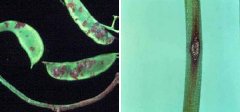 caused by Colletotrichum lindemuthianum.
caused by Colletotrichum lindemuthianum. - Black, sunken lesions about ½ inch in diameter develop on stems, pods and seedling leaves (cotyledons) but are most prominent on pods.
- A salmon-colored ooze on lesions and the veins on lower leaf surfaces turns black. On lima beans, symptoms are sooty- appearing spots on leaves and pods.
- Anthracnose develops primarily during the spring and fall when the weather is cool and wet, and not during hot, dry summers. Lima beans are particularly susceptible.
Survival and spread:
- The fungus survives in the winter primarily in bean seed. Survival in soil or in plant residue varies greatly, depending on environmental conditions.
- The fungal spores are easily carried to healthy plants in wind-blown rain and by people and machinery moving through contaminated fields when the plants are wet.
Favourable conditions:
- The disease is favored by warm (20o C to 24o C) weather and infection will only take place if the leaves remain wet for 18 to 24 hours.
Rust
Disease symptom:
- Bean rust is mainly a disease of leaves that causes rust-colored spots formation on the lower leaf surfaces.
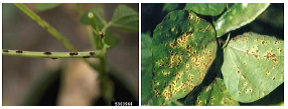
- Severely infected leaves turn yellow, wilt, and drop off the plant.
- Stems and pods may also be infected.
- It affects most types of beans under humid conditions.
Survival and spread:
- The pathogen survives in the volunteer Lablab bean plants and in infected plant debris in the soil as teliospores.
- The disease spreads by wind-borne uredospores from infected crop.
Favourable conditions:
- Day temperature of 25.5° to 30.5°C with relative humidity of 86 to 92 per cent enhances intensity of rust.
Powdery mildew
Disease symptom:
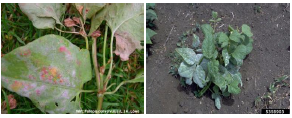 Leaves are covered with patches of a whitish to grayish powdery growth.
Leaves are covered with patches of a whitish to grayish powdery growth.- New growth appears contorted, curled or dwarfed and may turn yellow and drop. Pods are dwarfed and distorted.
- This is mostly a problem of all beans. Powdery mildew is spread by wind and rain.
Survival and spread:
- The primary sources of inoculum are oospores present in the soil.
- Secondary infection is by air
Favourable conditions:
- The disease is more under dry conditions at the end of the winter months.
Bacterial leaf spot
Disease symptom:
- There are two widespread bacterial blights that affect most types of beans, common blight (Xanthomonas campestris pv phaseoli) and halo blight (Pseudomonas syringae pathovar phaseolicola).
- The stems, leaves and fruits of bean plants can be infected by either disease. Rain and damp weather favour disease development.
- Halo blight occurs primarily
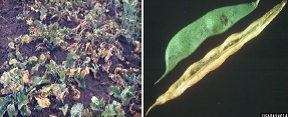 when temperatures are cool.
when temperatures are cool. - Light greenish-yellow circles that look like halos form around a brown spot or lesion on the plant. With age, the lesions may join together as the leaf turns yellow and slowly dies. Stem lesions appear as long, reddish spots.
- Leaves infected with common blight turn brown and drop quickly from the plant.
- Common blight infected pods do not have the greenish-yellow halo around the infected spot or lesion. Common blight occurs mostly during warm weather.
Survival and spread:
- The bacteria overwinter in dead plant material, but do not survive for long in water or soil.
- Bacteria are weak pathogens and need a natural opening (stomata’s and lenticels) or an injury (mechanical, insect or another disease) to infect. The disease is spread by splashing water and by implements or workers in the field when the plants are wet.
Favourable conditions:
- Warm temperature (24- 30°C) along with sprinkler irrigation or heavy rains favour disease development.
Lablab bean Mosaic virus
Disease symptom:
- Infected leaves show sharply defined
 patches of unusual coloration.
patches of unusual coloration. - The causal agents of these symptoms may be nutrient imbalance or herbicide injury or result from infection by one of several viruses. Southern beans can be infected by Cowpea aphid-borne mosaic virus, Bean common mosaic virus and several others.
- It is not possible to distinguish between the viruses based on symptoms alone.
- Laboratory tests (ELISA) are required to identify the viruses and confirm that they may be responsible for the mosaic symptoms.
Survival and spread:
- Virus spreads through transmission by thrips.
- Weed hosts serve as natural virus reservoirs.
- Long and continuous dry spell increases the disease incidence.
Ashy stem blight
Disease symptom:
- Symptoms may appear after soil-borne mycelia or
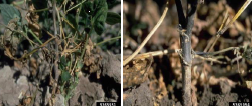 sclerotia germinate and infect seedling stems near the soil line at the base of developing cotyledons.
sclerotia germinate and infect seedling stems near the soil line at the base of developing cotyledons. - The fungus produced black, sunken, cankers which have a sharp margin and often contain concentric rings.
- The plant’s growing tip may be killed or the stem broken where it is weakened by the canker. Infection may continue into the hypocotyl and root region or the primary leaf petioles.
- Older seedling and plant infections may cause stunting, leaf chlorosis, premature defoliation, and plant death [Schwartz, 1989].
Survival and spread:
- M. phaseolina survives as microsclerotia in the soil and on infected plant debris.
- The microsclerotia serve as the primary source of inoculum.
- Wind-borne conidia cause secondary spread.
- Seeds may also carry the fungus in the seed coat.
- Germination of the microsclerotia occurs throughout the growing season when temperatures are between 28°C and 35°C.
Disease cycles:
Anthracnose
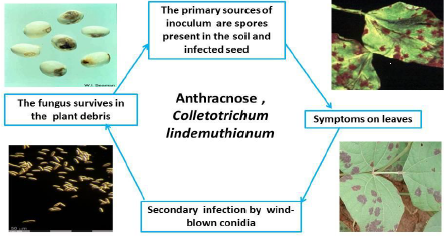
Rust
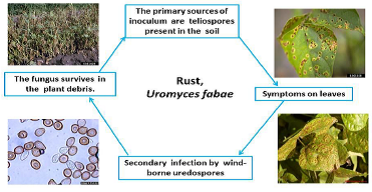
Powdery mildew
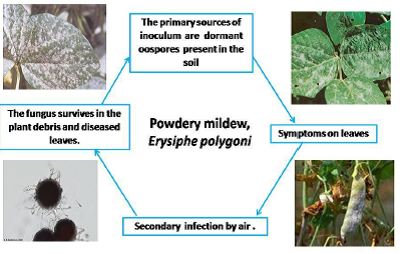
Bacterial leaf spot
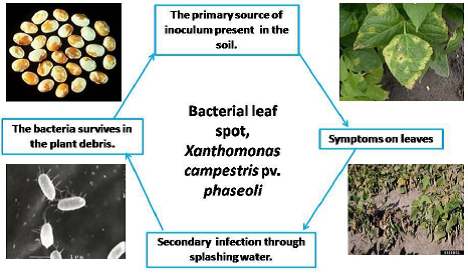
Mosaic virus
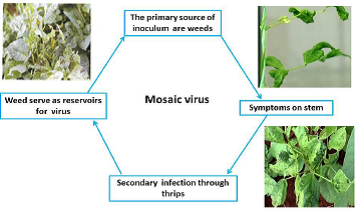
Ashy stem blight
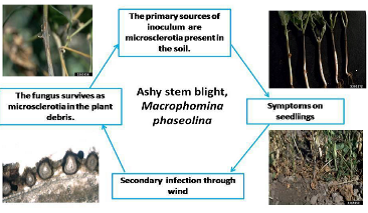
IPM for Lablab
To know the IPM practices for Lablab , click here.
Source: NIPHM, Directorate of Plant Protection, Quarantine Storage
Last Modified : 11/17/2020
© C–DAC.All content appearing on the vikaspedia portal is through collaborative effort of vikaspedia and its partners.We encourage you to use and share the content in a respectful and fair manner. Please leave all source links intact and adhere to applicable copyright and intellectual property guidelines and laws.
RELATED ITEMS
Fig Diseases
This topic covers information about Fig Diseases.
Fenugreek Diseases
This topic covers information about Fenugreek Dis...
Blackgram & Greengram: Diseases and Symptoms
This topic covers the Information related to Disea...
Amla Diseases
This topic covers information about Amla Diseases ...
